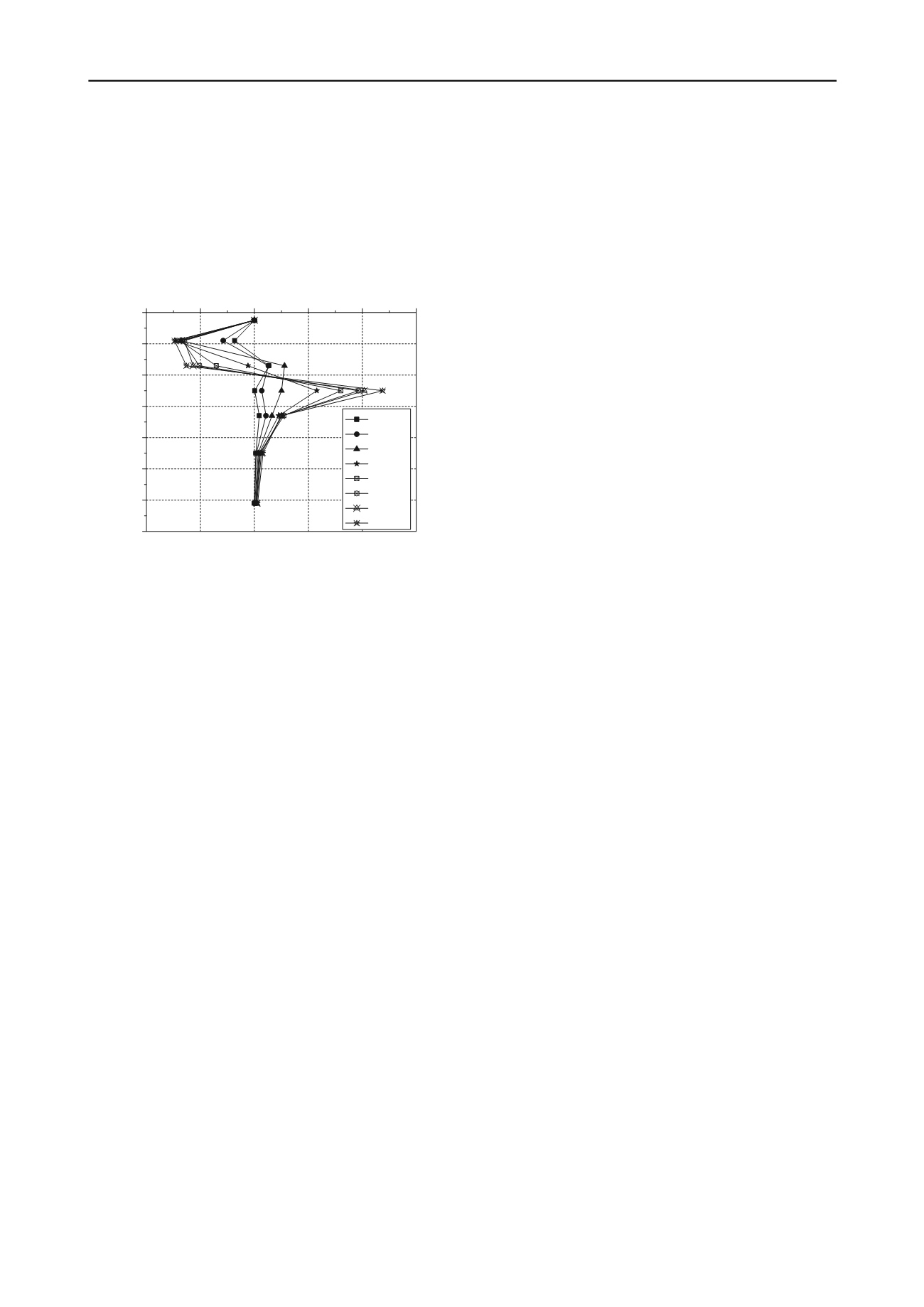
2960
Proceedings of the 18
th
International Conference on Soil Mechanics and Geotechnical Engineering, Paris 2013
the load shared by the soil, so the differential settlement is
increscent. Because the compressibility of the soil is far greater
than the pile, the settlement of the soil is far larger than the pile,
as a result, the displacement of the soil is downward with
respect to the pile and the downdrag is generated, that is the
negative friction. The larger the load pressure, the greater the
negative friction. The results in Fig. 4 also show that the
location of neutral points is about -2 m, which is almost
unchanged as the increase of the load.
8 REFERENCES
Alzamora, D. E. , Wayne, M. H. , and Han, J. (2000). “Performance of
SRW supported by geogrids and jet grout columns.”
Proc., Sessions
of ASCE Specialty Conf. of Performance Confirmation of
Constructed Geotechnical Facilities
, A. J. Lutenegeer and D. J.
DeGroot, eds., ASCE Geotechnical Special Publication, Reston, Va.,
Vol. 94 , 456–466.
American Association of State Highway Officials/Federal Highway
Administration (2002). Innovative technology for accelerated
construction bridge and embankment foundations, Preliminary
Summary Rep. Prepared for Federal Highway Administration, U.S.
Dept. of Transportation, Washington, D.C.
-7
-6
-5
-4
-3
-2
-1
0
-1000
-500
0
500
1000
1500
Single pile
37 kPa
75 kPa
113 kPa
150 kPa
188 kPa
225 kPa
263 kPa
300 kPa
Friction of pile shaft
f
s
(kPa)
Depth
h
(m)
Arulrajah, A., Abdullah, A., Bo, M. W., and Bouazza, A. (2009).
“Ground improvement techniques for railway embankments.”
Ground Improvement
, 162(1), 3-14.
Arulmoli, A. K., Varatharaj, R. S., Posadas, J., Afewerki, R., Jaradat,
O., and Lim, A. (2010). “Geotechnical challenges associated with
the design of a new marine oil terminal at the port of Los Angeles.”
In:
Ports 2010: Building on the Past, Respecting the Future
Proceedings of the Ports 2010 Conference
, ASCE, Florida, 252-261.
Bakholdin, B. V., Yastrebov, P. I., and Chashchikhina, L. P. (2009).
“Resistance characteristics of soils in the beds of precast piles.”
Soil Mech. Found. Eng.
, 46(2), 39-44.
Chen, R. P., Xu, Z. Z., Chen, Y. M., Ling, D. S., and Zhu, B. (2010
a
).
“Field tests on pile-supported embankments over soft ground.”
J.
Geotech. Geoenviron. Eng.
, 136 (6), 777-785.
Figure 4. The distributions of friction of pile shaft along pile depth
under different vertical load.
Chen, Y. H., Wang, X. Q., Liu, H. L., Jiang, L., and Zhang, T. (2010
b
).
“In-situ study on stress distribution of foundation improved by Y-
section pile.” In:
Ground Improvement Technologies and Case
Histories
, Leung et al. ed., Geotechnical Society of Singapore,
Singapore, 319-330.
6 SUMMARY AND CONCLUSIONS
Based on large-scale load tests and field test of a XCC pile
carried out in this paper, the following conclusions may be
drawn.
Dzhantimirovk, H. A., and Yalaev, R. R. (2009). “Form-free procedure
for fabrication of prestressed piles with no transverse
reinforcement.”
Soil Mech. Found. Eng.
, 46(2), 69-76.
(1) Regarding the contact area of pile-soil interface and EI of
piles, XCC piles can increase these values in comparison to
circular piles for the same amount of concrete volume used. The
large-scale test in a load testing facility indicated that load
carrying capacity of XCC pile exhibit a slightly higher capacity
than circular pile when the same amount of concrete volume
was used. Under the same working load level, XCC pile can be
constructed with less concrete volume and exhibits smaller
settlement when compared to the circular piles.
Eekelen, S. J. M. van, and A. Bezuijen (2008). “Design of piled
embankments, considering the basic starting points of the British
Design Guideline.”
Proc. of EuroGeo 4,
Sep. 2008, Edinburgh UK.
Gniel, J., and Bouazza, A. (2009). “Improvement of soft soils using
geogrid encased stone columns.”
Geotext. Geomembr.
, 27(3), 167-
175.
Han, J., and Gab, M. A. (2002). “Numerical analysis of geosynthetic-
reinforced and pile-supported earth platforms over soft soil.”
J.
Geotech. Geoenviron. Eng.
, 128(1), 44-53.
(2) The X cross section type offers a more reasonable section
form as compared with other traditional pile sections from on
the standpoint of offering contact areas of pile-soil interface and
lateral stiffness. The contact areas of pile-soil interface can be
improved obviously without the increasing of concrete
consumption. XCC pile is also an economic environment new
pile type. With less concrete usage can get the same treatment
effect. In this case study, the maximum values of axial force of
pile shaft is located on the -2 m deep, the location of neutral
points is about -2 m of pile depth.
JGJ94. (2008). “Technical code for building pile foundations.” Beijing,
China Architecture and Building Press. (in Chinese)
Jones, C. J. F. P. , Lawson, C. R. , and Ayres, D. J. (1990). “Geotextile
reinforced piled embankments.”
Proc., 4th Int. Conf. on Geotextiles,
Geomembranes and Related Products
, International Geosynthetics
Society, 155–160.
Lei, G. H. (2001). “Behavior of excavated rectangular piles (barrettes)
in granitic saproletes.” Ph.D. thesis, The Hong Kong University of
Science and Technology, Hong Kong.
Liu, H. L. (2007). “In-situ X-section reinforced concrete pile
construction method.” China patent ZL200710020306.3.
Liu, H. L., Chu, J., and Deng, A. (2009). “Use of large-diameter, cast-in
situ concrete pipe piles for embankment over soft clay.”
Can.
Geotech. J.,
46(7), 915-927.
7 ACKNOWLEDGEMENTS
The authors acknowledge the financial support from the
National Science Joint High Speed Railway Foundation of
China (No. U1134207), and the National Science Foundation of
China (No. 51008116, 51278170).
So, A. K. O., and Ng, C. W. W. (2009). “Performance of long-driven H-
piles in granitic saprolite.”
J. Geotech. Geoenviron. Eng.
,
135(2),
246-258.
Suh, K., Shin, S., and Cox, D. (2006). “Hydrodynamic Characteristics
of Pile-Supported Vertical Wall Breakwaters.”
J. Waterway, Port,
Coastal, Ocean Eng.
, 132(2), 83–96.


